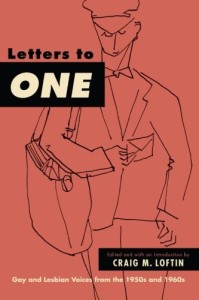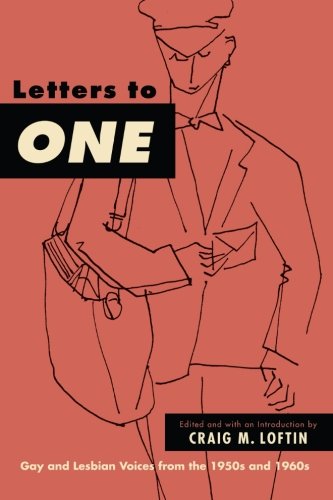 Letters to ONE: Gay and Lesbian
Letters to ONE: Gay and Lesbian
Voices from the 1950s and 1960s
Craig Loftin
SUNY Press. 238 pages, $24.95
ONE MAGAZINE, America’s first openly gay publication, was launched in Los Angeles in January 1953. It continued going strong for almost a decade, until an internal split in the parent organization, One Inc., weakened the magazine. Still, it continued to publish in a diminished form up to 1967, only two years before Stonewall. I remember ONE well from the early 1960s, and have almost a complete run, which W. Dorr Legg, the long-time leader (some would say dictator) of One Inc., brought to me when he was visiting New York City.
Letters to ONE is not, as I had expected, a selection of letters published by ONE magazine but, instead, almost entirely a selection of letters that were received but not published. Some of these letters were too long for publication, others were too personal, still others would have jeopardized One’s precarious right to send through the mail. Editor Craig Loftin comments, “The writers’ candor about sex in these letters is a striking contrast to the sexually neutered contents of ONE magazine.”
An example of the unpublishably candid letters is one from Michael, a cock fetishist who wanted sources of nude photos that could be sent through the mail: “Society, unfortunately, has the view that this one area of only a few square inches is ‘dirty’ and ‘vulgar’ and that in no case should this extremely important and absolutely vital organ of the male body ever be glorified or even photographed. … I want the right to appreciate 100% of the masculine physique.”
In re-reading my own copies of ONE, I found some interesting and controversial letters that were published, though they’re not included in this book. Women played an important role in the first few years of the magazine, but in time the staff became entirely male. The editors tried in vain to attract more female readers, but since most of the contributors were male, as were 90 to 95 percent of the letters, male experiences predominated. The issue of July 1958 featured an editorial by “Alison Hunter”—a corporate pseudonym used primarily by W. Dorr Legg—lamenting that many gay men and lesbians didn’t like each other, and that some homophile organizations excluded men (Daughters of Bilitis) or excluded women (Der Kreis in Switzerland). This provoked an acerbic response from “Noel I. Garde” (real name: Edgar Leoni), author of the seminal book Jonathan to Gide: The homosexual in history (1964):
When the study of homosexuality is freed from this dogmatic [Freudian] claptrap, when properly viewed as something positive, the obvious fact will be brought out that the primary, positive essence of male homosexuality is an inherent and very strong attraction to the male. Of all females with whom such a male has the least in common, the Lesbian obviously comes first. If it is considered desirable for the male homosexual to associate more with his female equivalent, he should look for same amongst nymphomaniacs, his true female counterpart.
Rolf, the one-named editor of Der Kreis (“the circle”), which published continuously from 1932 to 1967, wrote to say that he and Mammina (Anna Vock), the woman who founded Der Kreis, concluded after ten years that “though the interests of homophile women and men are identical, their ways of living socially together are—at least in Switzerland—incompatible.” He added, “generally women of our kind tend to be not only critical but super-critical of their brothers in kind, whereas the male homophile is far more tolerant toward his sisters.”
In his excellent introduction, Loftin states: “These letters offer a unique window into the collective thoughts and experiences of gay people at a time when their sexual identities and communities were often camouflaged and shrouded to secrecy.” Yes, indeed! My own adolescence occurred in the hellish conformity of the 1950s: McCarthyism, purges of sexual deviants from the State Department, castration and electric shock treatment for gay men, and vicious anti-gay yellow journalism. In those benighted days, if a man admitted in an unguarded moment that he was attracted to males, this would mean a loss of career, reputation, and perhaps even life—notwithstanding the Kinsey studies of the 1940s, which had shown that a large minority of American men (37 percent) had experienced sex with a male to the point of orgasm.
By and large, however, those who wrote to ONE were not racked by guilt and shame, but evinced a self-acceptance that was almost a precursor of post-Stonewall gay pride. Of course, concealment was necessary, but Loftin cogently distinguishes between being in the closet and wearing a mask:
They did not imagine themselves dwelling in some vast closet, but imagined themselves wearing masks that enabled them to pass as heterosexual when necessary in order to avoid antigay persecution. A “mask” is a very different metaphor than a “closet.” Closets are dark places where people hide. Masks imply subterfuge, resistance, defiance, and perhaps most importantly, human agency.
One correspondent wrote: “Wouldn’t it be wonderful if homosexuals today could walk with head high, proud of the fact—instead of hiding in the dark crevices of society like Medieval monsters.” Another mused: “This leads me to wonder if the theory that the tendency isn’t latent in all of us, isn’t the most logical one.” Still another: “I believe that no nobler bond of affection exists than that love which unites the hearts of two men.”
However, some correspondents were isolated and desperately needed to talk to someone, if only through letters: “I’m always alone.” ONE received distraught letters calling out for help: “Please help me before my life is tore to pieces and I have to face the mental ward.” Some of the writers described horrible injustices they had suffered. One, after an undesirable discharge from the Navy, had a complete schizophrenic reaction and was put in a state hospital for ten months: “I had 15 electric shock treatments and 45 days of insulin shock therapy.”
In correspondence with ONE editor Don Slater, Timothy, a male nurse, described at length his incarceration in a Florida prison. After release, despite excellent qualifications and work history, he was unable to obtain employment of any kind: “If a homosexual has a problem in finding or holding a job, then a homosexual with a prison record has the same problem multiplied a thousand-fold.” Cyrus, an occasional ONE magazine volunteer and contributor, wrote a series of letters to ONE’s Jim Kepner from a mental hospital in which he was incarcerated as an alternative to prison. These letters covered a wide range of topics, including sociology, literature, and sexuality. Loftin comments that writing these letters was “a strategy for staying sane in an environment in which he was completely out of place and did not belong.” Sometimes the ONE staff intervened. Two young men, unable to afford a lawyer, were in prison on a trumped-up charge of solicitation. ONE put them in touch with the Janus Society of Philadelphia, which obtained a good lawyer who handled the case on credit. They “were released without having to go through trial on a writ of habeas corpus.”
Craig Loftin has also written a companion book, Masked Voices: Gay Men and Lesbians in Cold War America (2012), which a publisher’s blurb described thus: “An analysis of unpublished letters to the first American gay magazine reveals the agency, adaptation, and resistance occurring in the gay community during the McCarthy era.” Taken together, this book and Letters to ONE make valuable contribution to GLBT history before Stonewall.
John Lauritsen recently edited translations of the Aeschylus plays, Oresteia and Prometheus Bound, by Percy Bysshe Shelley and his cousin Thomas Medwin (Pagan Press 2011).






